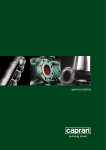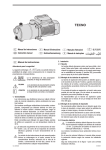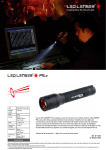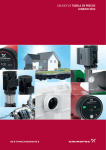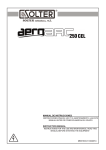Download Manual de instrucciones
Transcript
Tiper15 Manual de instrucciones Instruction manual Manual de instrucciones ADVERTENCIA PARA LA SEGURIDAD La conexión eléctrica debe ser realizada por personal técnico cualificado. La siguiente simbología junto a un párrafo indica la posibilidad de peligro como consecuencia de no respetar las prescripciones correspondientes. PELIGRO riesgo de electrocución. El cable de alimentación debe cumplir con las exigencias de las correspondientes normativas vigentes en cada país. Es de uso obligado que las conexiones del cable de alimentación al motor de la bomba, se hagan con los correspondientes terminales. La no advertencia de esta prescripción comporta un riesgo de electrocución. PELIGRO La no advertencia de esta prescripción comporta un riesgo de daño a personas o cosas. ATENCIÓN La no advertencia de esta prescripción comporta un riesgo de daños al equipo o a la instalación. Los motores monofásicos llevan protección térmica incorporada. Siga las instrucciones de la Figura 1 para una correcta instalación eléctrica. La instalación debe realizarse y siguiendo la norma "EN 60335-2-60". Asegurarse que la conexión del cable de masa se ha realizado correctamente. Asegurarse que la conexión equipotencial entre la bañera y la bomba se ha realizado correctamente. 1. GENERALIDADES Las instrucciones que facilitamos tienen por objeto informar sobre la correcta instalación y óptimo rendimiento de nuestras bombas. 2.5. Controles previos a la puesta en marcha inicial ATENCIÓN: Compruebe que la tensión y la frecuencia de la red corresponden a la indicada en la placa de características. Son bombas centrífugas monocelulares horizontales, con motor eléctrico incorporado. Diseñada para trabajar con equipos compactos de hidromasajes. Asegúrese que el eje de la bomba gira libremente. Con dispositivo de vaciado completo para evitar el líquido residual en cada puesta en marcha. Deberá dotarse de un dispositivo, en el conjunto de hidromasaje, para que la bomba no se ponga en marcha si no existe un mínimo nivel de agua. Llene la bañera. Deberá esperar a que el agua alcance dicho nivel (Figura 2). Con aislamiento entre parte motor y bomba superior a 3750 V. Concebida para trabajar con aguas limpias, exentas de sólidos en suspensión y a una temperatura máxima de 50°C. Asegúrese de que no exista ninguna junta o rácor con pérdidas. LA BOMBA NO DEBE FUNCIONAR NUNCA EN SECO. ATENCIÓN: el adecuado seguimiento de las instrucciones de instalación y uso, así como de los esquemas de conexión eléctricos garantiza el buen funcionamiento de la bomba. 3. PUESTA EN MARXA Abra todas las válvulas de paso en las tuberías, tanto en la aspiración como en la impulsión. PELIGRO: La omisión de las instrucciones de este manual puede derivar en sobrecargas en el motor, merma de las características técnicas, reducción de la vida de la bomba y consecuencias de todo tipo, acerca de las cuales declinamos cualquier responsabilidad. Conecte el interruptor de suministro. El agua puede tardar unos segundos en recorrer toda la longitud de tubería. Compruebe el sentido de giro del motor, este debe ser horario visto desde el ventilador. Compruebe que la corriente absorbida sea igual o menor a la máxima, indicada en la placa de características. 2. INSTALACIÓN 2.1. Fijación Si el motor no funciona o no extrae agua, procure descubrir la anomalía a través de la relación de posibles averías más habituales y sus posibles soluciones que facilitamos en páginas posteriores. La bomba deberá descansar sobre una base sólida y horizontal. Debe estar fijada a ella mediante tornillos (4 x Ø8), aprovechando los agujeros que existen en el soporte, para asegurar la estabilidad del montaje. 2.2. Montaje de la tubería de aspiración 4. MANTENIMIENTO La tubería de aspiración debe poseer un diámetro igual o superior al de la boca de entrada de la bomba, conservando permanentemente una pendiente ascendente mínima del 2% para evitar bolsas de aire y para posibilitar el vaciado de la bomba (Figura 2). Nuestras bombas están exentas de mantenimiento. Si se prevé un tiempo de inactividad prolongada se recomienda desmontar la bomba y guardarla en un lugar seco y ventilado. 2.3. Montaje de las tuberías de impulsión ATENCIÓN: en caso de avería, la manipulación de la bomba sólo puede ser efectuada por un servicio técnico autorizado. Se recomienda utilizar tuberías de un diámetro igual al de la boca de impulsión o mayor para reducir las pérdidas de carga en tramos largos de tuberías. Las tuberías jamás descansarán su peso sobre la bomba. 5. DESGUACE Llegado el momento de desechar la bomba, esta no contiene ningún material tóxico ni contaminante. 2.4. Conexión eléctrica Este producto no debe ser tirado al contenedor normal de basuras. Utilice el servicio local, público o privado, de recogida selectiva de residuos. La instalación eléctrica deberá disponer de un sistema de separación múltiple con abertura de contactos ≥ 3 mm. La protección del sistema se basará en un interruptor diferencial (I∆n = 30 mA). Los componentes principales están debidamente identificados para poder proceder a un desguace 1 selectivo. Instruction manual SAFETY WARNING The electrical connection must be carried out by a qualified technician. next to a paragraph The following symbology indicates possible danger as a result of not respecting the corresponding warnings. DANGER risk of electric shock. The power cable must comply with the corresponding regulation requirements in force in each country. It is obligatory that the connections from the power cable to the motor of the pump are made with the corresponding terminals. Not heeding this warning carries a risk of electric shock. DANGER Not heeding this warning carries a risk of harming people or things. WARNING Not heeding this warning carries a risk of damaging the equipment or the installation. The single-phase motors incorporate thermal protection. Follow the instructions in Figure 1 for correct electrical installation. The installation should be carried out in accordance with regulation "EN 60335-2-60". Check that the grounding connection has been carried out correctly. Check that the equipotential connection between the bath tub and the pump has been carried out correctly. 2.5. Tests prior to initial start-up 1. GENERALITIES WARNING: Check that the tension and frequency of the supply system correspond to that indicated on the electrical data label. The instructions provided give information about the correct installation and optimal performance of our pumps. Make sure that the shaft of the pump rotates freely. They are centrifugal single-stage horizontal pumps, with electric motor incorporated. It should be fitted with a device, in the hydro-massage unit, so that the pump does not start until there is a minimum level of water. Fill the bath tub. Wait until the water reaches the aforementioned level (Figure 2). Designed for working with hydro-massage compact equipment, with complete draining device to avoid residual liquid in each startup. Make sure that none of the gaskets or fittings leak. With insulation between the motor part and the pump exceeding 3750 V. THE PUMP MUST NEVER BE DRY RUN. Designed for working with clean water, that does not contain suspended solids and at a maximum temperature of 50°C. 3. START-UP Open all the flow valves on the tubes, on both the suction and discharge. WARNING: correctly following the instructions for installation and use, as well as the diagrams for electrical connections guarantees the correct functioning of the pump. Connect the supply switch. The water make take a few seconds to flow along the length of the tube. Check the rotational direction of the motor; it should be clockwise when looked at from the ventilator. DANGER: Disregarding the instructions in this manual may result in overcharges in the motor, loss of technical characteristics, reduction in the useful life of the pump and consequences of all types, for which we do not take any responsibility. Check that the absorbed current is equal to or less than the maximum, indicated on the electrical date label. If the motor does not work or does not extract water, try to find out what the anomaly is by checking the most common possible faults and their possible solutions that we have provided on later pages. 4. MAINTENANCE 2. INSTALLATION Our pumps are exempt from maintenance. 2.1. Fastening If the pump is going to be inactive for a long time it is advisable to dismantle it and store it in a dry, ventilated place. The pump should rest on a solid, horizontal base. It should be fastened to it using screws (4 x Ø8), making use of the holes in the support to ensure that the assembly is stable. WARNING: in the case of breakdown, the pump may only be handled by an authorised technical service. 2.2. Assembly of the suction pipe The suction pipe should have a diameter the same as or exceeding that of the mouth of the pump inlet, permanently maintaining a minimum incline of 2% to avoid air pockets and so that can make the draining of the pump possible (Figure 2). 5. DISPOSAL When the time comes to dispose of the pump, it does not contain any toxic or contaminating material. 2.3. Assembly of the discharge pipe This product must not be disposed of in a normal rubbish container. Use the local public or private service for selective residue collection. It is advisable to use pipes with a diameter equal to that of the propulsion mouth or bigger to reduce power losses in long stretches of pipes. The principal components are duly identified for a selective disposal procedure. The pipes should never rest their weight on the pump. 2.4. Electrical connection The electrical installation must be fitted with a multi-pole isolator with an opening of contacts ≥ 3 mm. The protection of the system is based on a differential switch (I∆n = 30mA). 2 Fig. 1 ALIMENTACIÓN MONOFÁSICA SINGLE-PHASE SUPPLY Fig. 2 TUBERIA DE ASPIRACIÓN SUCTION PIPE 1 - ROJO RED 2 - BLANCO WHITE 3 - NEGRO BLACK 4 - CONDENSADOR CAPACITOR 5 - LÍNEA LINE 6 - PROTECTOR TÉRMICO THERMAL PROTECTOR TUBERIA DE IMPULSIÓN DISCHARGE PIPE NIVEL MÍNIMO DE AGUA MINIMUM WATER LEVEL Dimensiones / Dimensions 230V 50Hz Tiper15 1 Q max. H max. [l/min.] [m] 250 8,5 A 1~ 230V 1,9 12 P1 [kW] 0,4 C - mf IP h (%) 55 40 dBA ±1 < 70 A [mm] 36,5 B [mm] 158 C [mm] 78 D [mm] 153 E [mm] 80 G [mm] 309 F [mm] 100 H [mm] 126 J [mm] 177 K [mm] 100 kg 5,7 Tiper15 2 300 9,2 2,4 12 0,55 55 42 < 70 36,5 158 78 153 80 309 100 126 177 100 5,7 Tiper15 3 350 10 3 12 0,7 55 44 < 70 36,5 158 78 153 80 323 100 126 177 100 6,7 V/Hz esp.: Ver placa datos bomba / See pump nameplate. 3 1 - Cuerpo bomba Pump body 2 - Rodete Impeller 3 - Tapa bomba Pump cover 4 - Cierre mecánico Mechanical seal 5 - Rodamiento Bearing 6 - Condensador Capacitor 7- Motor shaft Eje motor 8 - Estator Stator 9 - Racor aspiración 10- Racor impulsión Suction union Discharge union C/134891 Edición: 01/09/2006 4




